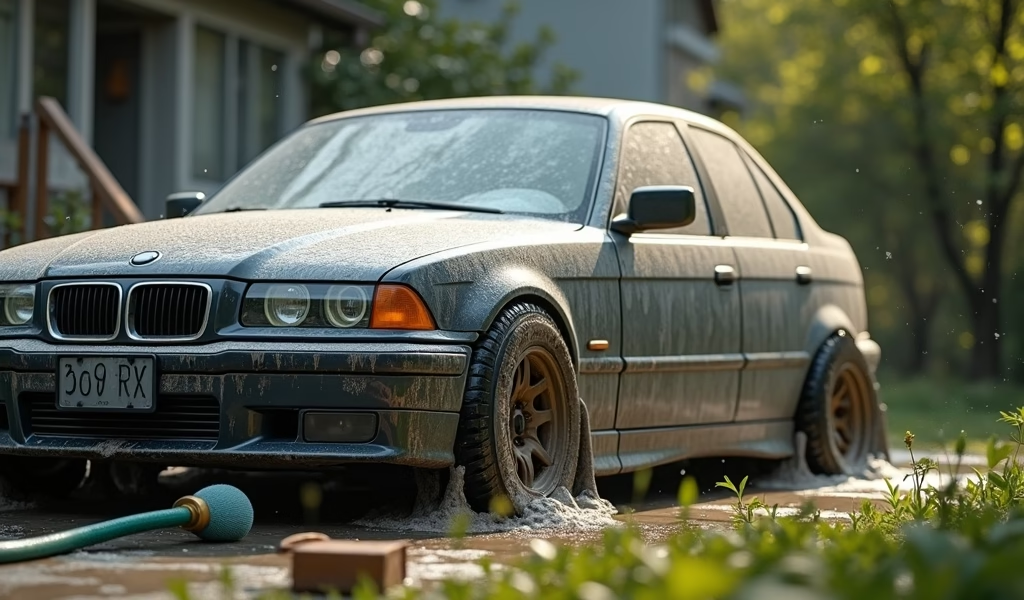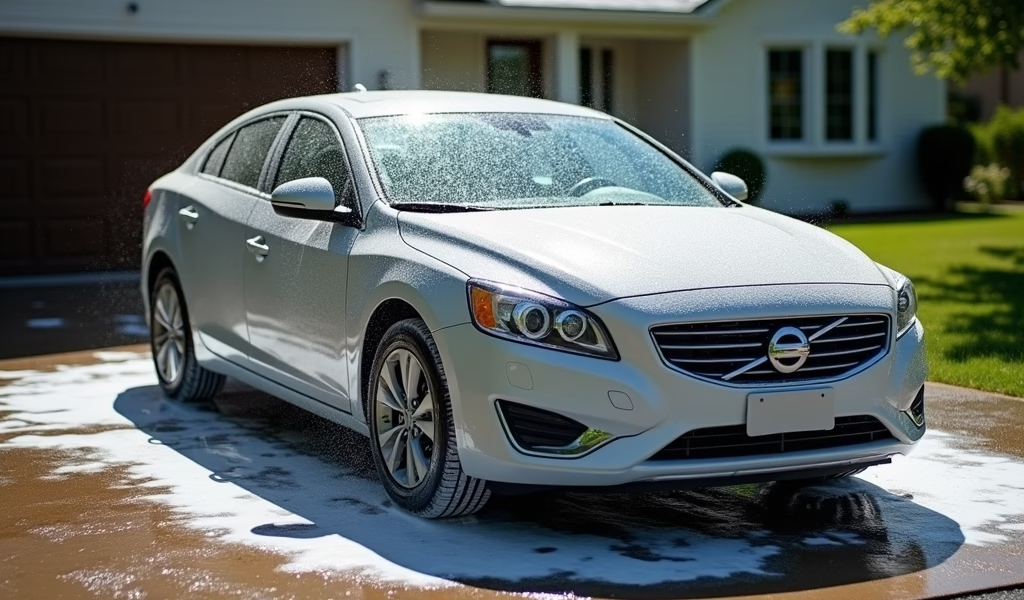Overview
This article provides a detailed guide on achieving professional-quality car washing results at home, covering essential supplies, proper techniques, and common mistakes to avoid. It emphasizes that home car washing not only saves money but also provides better care for your vehicle through the two-bucket method, proper drying techniques, and finishing touches like waxing that protect your car’s paint and value.
Table of Contents
- Why Wash Your Car at Home?
- Essential Supplies for a Home Car Wash
- Pre-Wash Preparation
- Proper Washing Technique
- Drying Methods That Prevent Water Spots
- Wheels and Tires: The Often Overlooked Areas
- Final Touches: Waxing and Detailing
- Conclusion
- Frequently Asked Questions
Why Wash Your Car at Home?
Washing your car at home isn’t just about saving a few bucks – it’s about giving your vehicle the personalized care it deserves. As someone who’s worked on cars professionally for over 15 years, I can tell you that a proper car wash at home offers benefits that drive-through washes simply can’t match. You’ll have complete control over which products touch your paint, how thoroughly each section gets cleaned, and you can address specific trouble spots that automated washes might miss.
Beyond the quality aspect, there’s something genuinely satisfying about transforming your grimy vehicle into a gleaming showpiece with your own two hands. It’s an opportunity to inspect your car closely, catching minor issues before they become major problems. Plus, you’ll avoid those harsh brushes at commercial car washes that can microscopically scratch your clear coat over time – what we in the industry call “swirl marks.”
If you’re concerned about water usage, you might be surprised to learn that home car washing can be more eco-friendly than commercial options when done properly. Most drive-through washes use 35-85 gallons per vehicle, while a thoughtful home wash can use as little as 10-15 gallons. Let’s dive into how to get professional-quality results right in your own driveway.
Essential Supplies for a Home Car Wash
Getting professional results starts with having the right tools. Skip the dish soap – it strips away protective wax and can damage your paint over time. Instead, invest in these essentials:
- Car-specific wash soap (pH-balanced to protect your paint)
- Two wash buckets (one for soap, one for rinsing)
- Grit guards for both buckets (prevents redepositing dirt onto your car)
- Microfiber wash mitt or sponge (gentler than regular cloths)
- Wheel brush and tire cleaner (designed for specific wheel finishes)
- Microfiber drying towels (prevents water spots)
- Hose with adjustable nozzle or pressure washer
The two-bucket method might sound excessive, but it’s a game-changer for preventing swirl marks. When you drag your wash mitt across dirty paint, it collects grit. Rinsing in a separate bucket before reloading with soap ensures you’re not rubbing that same grit back across your paint. This simple technique is one of the most valuable car wash tools professionals use.
For those looking to level up their home detailing game, consider adding clay bars, spray detailers, and carnauba wax to your arsenal. These products remove embedded contaminants and add that showroom shine that turns heads. While they’re not essential for a basic wash, they make a noticeable difference in your car’s final appearance.

Pre-Wash Preparation
Proper preparation is the foundation of a successful car wash at home. Start by finding a shaded spot – direct sunlight causes soap and water to dry too quickly, leaving stubborn spots that are difficult to remove. The ideal temperature range is between 50-80°F; extreme heat or cold can affect how products perform.
Next, give your car a thorough pre-rinse with a hose or pressure washer. This initial step loosens and removes surface dirt and debris that could scratch your paint during the washing process. Pay special attention to lower panels, wheel wells, and front bumpers where road grime, bugs, and tar tend to accumulate.
If you’re using a pressure washer, maintain a safe distance of at least 12 inches from the paint surface and use a 40-degree nozzle or wider. While pressure washers are excellent for initial cleaning, they can damage paint, rubber seals, and emblems if used incorrectly. When in doubt, less pressure is better than more.
Here’s a professional tip many overlook: work from top to bottom. Gravity pulls dirty water downward, so starting at the roof and working your way down prevents you from having to rewash areas. This simple approach is the cornerstone of efficient hand car washing techniques used by detailing professionals.
Proper Washing Technique
Now that you’re prepped, let’s talk technique. Fill your first bucket with the manufacturer-recommended amount of car wash soap and water. Fill your second bucket with clean water only. Place grit guards in both buckets if you have them.
Dunk your microfiber wash mitt into the soapy water, then start at the roof. Work in straight lines rather than circular motions – circular scrubbing can create noticeable swirl marks in your clear coat when the sun hits it just right. After washing a section, rinse your mitt in the clean water bucket before reloading with soap.
Divide your car into manageable sections and rinse each section immediately after washing it. Don’t let soap dry on the surface, as this can leave stubborn spots and residue. I recommend this washing order for maximum efficiency:
- Roof and upper windows
- Hood and trunk
- Upper door panels and upper quarter panels
- Lower door panels and lower quarter panels
- Front and rear bumpers (typically the dirtiest parts)
For heavily soiled areas like bumpers or lower panels caked with road grime, consider using a separate wash mitt dedicated to these dirtier sections. This prevents transferring heavy contaminants to cleaner areas of your vehicle. Some detailers even use specialized bug and tar removers for stubborn spots that regular soap won’t touch.
Remember to keep your wash mitt well-saturated with soapy water – a dry mitt creates friction that can mar your paint. The slicker the surface feels as you’re washing, the less likely you are to create micro-scratches.
Drying Methods That Prevent Water Spots
Drying might seem straightforward, but it’s where many DIY car washers fall short. Water spots occur when minerals in tap water remain on your paint after the water evaporates. These spots aren’t just unsightly – they can etch into your clear coat if left too long, especially in areas with hard water.
The most effective drying method uses plush microfiber drying towels. Unlike regular towels or chamois, quality microfiber towels can absorb up to seven times their weight in water without scratching. Pat dry rather than wipe when possible, and change to a fresh towel once your current one becomes saturated.
For an even more professional approach, consider these advanced drying methods:
- Blower method: Using a leaf blower or dedicated car dryer to force water off the surface (perfect for reaching crevices)
- Drying aid method: Spraying a quick detailer or spray wax while the car is still wet, which breaks surface tension and makes drying easier
- Squeegee method: Using a silicone water blade to remove most water before finishing with microfiber (use with caution as improper technique can cause scratches)
I personally recommend the combination approach – blow water from tight areas like mirrors and grilles, use a drying aid, then finish with quality microfiber towels. Whatever method you choose, speed is your ally. The quicker you dry after rinsing, the less chance water spots have to form.

Wheels and Tires: The Often Overlooked Areas
Wheels and tires deserve special attention during your car wash at home. These areas collect brake dust, road grime, and tar that regular car soap often can’t fully remove. Using dedicated wheel cleaners and tire dressings makes a dramatic difference in your car’s overall appearance.
Start by choosing the right wheel cleaner for your specific wheel finish. Harsh acidic cleaners can damage polished or coated wheels, while gentler pH-neutral formulas might not cut through heavy brake dust on neglected wheels. When in doubt, opt for products specifically labeled as safe for all wheel types.
Apply wheel cleaner to cool wheels (hot wheels from recent driving can cause cleaners to spot or stain), and use a wheel-specific brush to agitate the solution. The bristles should be stiff enough to clean effectively but soft enough not to scratch. Work from the inside out, as the inner barrel usually contains the most buildup.
For tires, use a tire brush with stiffer bristles to scrub away old dressings and embedded dirt. Some detailers prefer to clean wheels and tires first before washing the car’s body to prevent splash-back onto already-cleaned surfaces. This approach makes sense when you consider that wheels are typically the dirtiest part of the vehicle.
After cleaning, apply a quality tire dressing for that perfect finishing touch. Water-based dressings offer a natural satin finish, while silicone-based products provide that wet, glossy look. Either way, apply the product with an applicator pad rather than spraying directly to avoid sling onto your clean paint.
Final Touches: Waxing and Detailing
The washing process is complete, but for truly professional results, consider these finishing touches. A quality wax or sealant applied after washing not only enhances your car’s shine but also provides a protective layer against environmental contaminants. Think of it as sunscreen for your paint.
Traditional carnauba waxes offer warm, deep gloss but typically last 1-2 months. Synthetic sealants provide longer protection (3-6 months) with slightly less warmth in the finish. Ceramic coatings, the most advanced option, can protect for years but require more careful application. For most home detailers, a quality synthetic wax strikes the perfect balance between looks, protection, and ease of use.
Apply your chosen product in the shade using a foam applicator, working in straight lines on one panel at a time. Let it haze (partially dry) according to the manufacturer’s instructions, then buff off with a clean, dry microfiber towel. The key to streak-free results is using minimal product – a thin, even coat is far better than thick application.
Don’t forget these often-neglected areas that complete a professional-looking detail:
- Glass cleaning (use an automotive-specific glass cleaner for streak-free results)
- Trim dressing for faded plastic and rubber components
- Quick wipe-down of door jambs and other hidden areas
- Interior dashboard and console dusting
Building a complete car wash kit that includes these detailing products allows you to maintain your vehicle’s appearance between washes with quick touch-ups. Many professional detailers recommend keeping quick detailer spray and a clean microfiber in your trunk for addressing bird droppings or tree sap immediately – these contaminants can permanently damage paint if left too long.
Conclusion
A proper car wash at home goes beyond simply removing dirt – it’s about preserving your vehicle’s finish and value through thoughtful care. By following these professional techniques and using the right products, you can achieve results that rival or even exceed commercial car washes while building a deeper connection with your vehicle.
Remember that consistency matters more than perfection. Washing your car every 1-2 weeks prevents contaminants from bonding too strongly to your paint, making each wash easier than if you wait months between cleanings. Even a basic wash using proper technique will do more to protect your car’s finish than an improper wash with premium products.
Start with the fundamentals – two buckets, good technique, and thorough drying – then gradually expand your detailing routine as you become more comfortable. Your car is likely one of your largest investments, and these simple maintenance steps will help preserve its appearance and value for years to come.
Whether you’re protecting a new vehicle or rejuvenating an older one, there’s immense satisfaction in stepping back to admire your freshly detailed car gleaming in the driveway – knowing you did it yourself with professional-grade care.
Frequently Asked Questions
How often should I wash my car at home?
Wash your car every 1-2 weeks to prevent contaminant buildup, more frequently if exposed to harsh environments like road salt or tree sap. Regular washing prevents dirt from bonding to your paint and becoming more difficult to remove.
Can I use dish soap to wash my car?
Never use dish soap as it strips protective wax and can damage your paint over time. Always use pH-balanced car wash soap specifically formulated for automotive finishes.
What’s the best time of day to wash my car?
Early morning or late afternoon in a shaded area provides optimal conditions for a car wash at home. Avoid washing in direct sunlight as it causes soap to dry too quickly, leading to water spots and streaking.
How can I prevent water spots when washing my car?
Dry your car immediately after rinsing using quality microfiber towels or a car dryer. For extra protection, use a quick detailer spray as a drying aid to break water surface tension.
Is it better to hand wash or use an automatic car wash?
Hand washing using proper technique is gentler on your paint and more thorough than automatic washes. Automatic washes often use harsh brushes that can create microscopic scratches in your clear coat over time.

